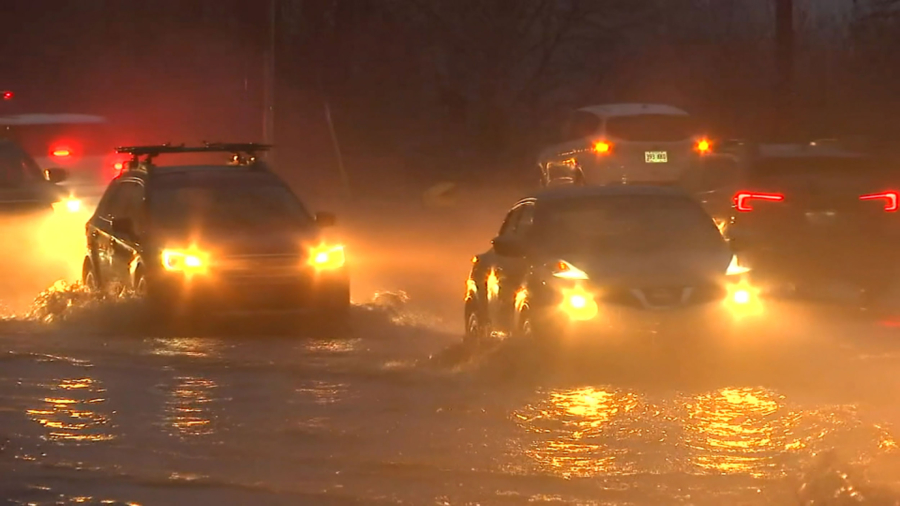Heavy coastal rain and mountain snow from a potent atmospheric river are falling across the western United States, with more to come later this week.
All 11 Western states are expecting rain or snow, with the heaviest impacts predicted for California.
The atmospheric river—a long, narrow region in the atmosphere that can transport moisture thousands of miles—is the reason flood watches were issued for more than 5.3 million people across much of the West Coast, including Seattle.
“A series of Pacific storm systems will affect the western US with heavy rain, mountain snow and strong winds into the weekend,” the National Weather Service said.
High-wind warnings for Pacific Northwest
More than 14.9 million people in the West are under wind alerts from the National Weather Service as of Tuesday evening as the storm system pushes inland.
A high-wind warning is in effect for much of the Pacific Northwest. The Seattle office of the weather service tweeted about 5 p.m. PT that there was a gust to 63 mph in Grays Harbor County. The Portland office said at 5:24 p.m. that “west wind finally made it to the Central Gorge and Upper Hood River Valley earlier today.”
In addition, wind advisories are also posted both in the Pacific Northwest as well as many other Western states.
Some of the top wind gusts included 90 mph in Walker, California; 84 mph in Cambridge, Idaho; and 82 mph in Wagontire, Oregon.
Strong winds in Portland could knock down trees that have been weakened by weather extremes in recent years, arborist Colin Bourgeois told CNN affiliate KATU.
“The consecutive dry summers that we’ve had, especially the heat events like the heat dome, that really damages trees and it takes up so much of their energy to fuel their immune systems to fight off pathogens,” Bourgeois said.
Portland Breaks a Rainfall Record
Areas to the west of Portland have seen up to 6 inches of precipitation in the past 24 hours, and the city on Monday broke a record for the date.
Portland recorded 2.12 inches of rain, topping the record of 1.08 inches set on December 26, 1996. Monday was the third-rainiest December day on record in Portland.
Over the next five days, rainfall across much of the West is forecast to be between 2-4 inches with isolated pockets up to 6 inches. Along the coast, rainfall is forecast to be between 4-6 inches with isolated areas potentially seeing higher.
Heavy Rains Could Bring Flash Floods
The greatest flash-flooding concerns are for the western foothills of the Sierra Nevadas, as well as the coastal portions of southern Oregon down through the Bay Area and to Los Angeles County.
Widely scattered instances of flash flooding are possible at lower elevations, particularly in burn scars from wildland fires.
Moderate to heavy rain has been falling across portions of the Bay Area since Monday night and is expected to keep falling for several days.
As of mid-morning Tuesday, downtown San Francisco had recorded 1.21 inches of rain, Santa Rosa 2.72 inches and Mount Tamalpais 4.10 inches.
Law enforcement had reports of roadway flooding, so the National Weather Service office issued a flood advisory, which was canceled a few hours later.
The storm will bring a temperature drop of 15–20 degrees to Southern California.
The weather service office in Northern California also warned of rough ocean conditions.
“Seas have built to between 16 and 22 feet along the Northwest California coast,” the office in Eureka said on Twitter. “This is causing dangerous marine conditions, but also bringing large surf to the coastline. Please stay far back from the surf and off of rocks/jetties.”
Weather System Could Help California Snowpack
In terms of snowfall, winter storm alerts have been issued for 11 Western states.
Over the next five days, lower elevation areas could see between 2–10 inches of snowfall with isolated areas getting 12–24 inches.
Snowfall in higher elevations could be between 1–3 feet with isolated areas seeing over 3 feet.
California is off to a fast start with snowpack, a critical source of water and good news for some improvement in drought conditions. As of late last week, the state’s snowpack was running more than 150 percent of normal, according to the California Department of Water Resources.
The CNN Wire contributed to this report.


